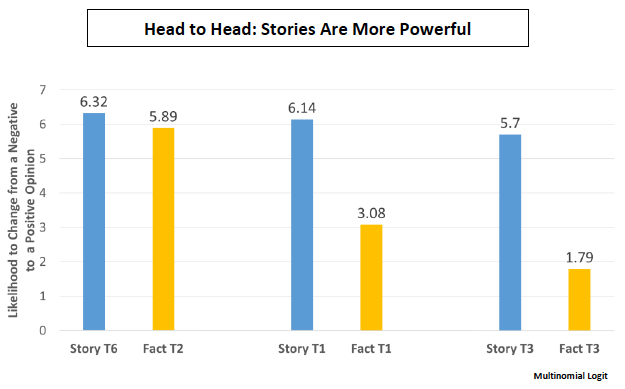Matthew Young and Darren Hawkins, Political Science
Presently, U.S. foreign aid only represents about 1% of the total US budget, but according to the Kaiser Family Foundation the majority Americans believe foreign aid to be 28% of the national budget. If that were the case, foreign aid would be more expensive than Medicare, Medicaid, Social Security, or all defense spending1. As of 2014, the U.S. Agency for International Development only used data heavy stories when communicating with the public. With such a large public misperception of aid a new method of communication must be found.
In the last five years, multiple revolutionary studies were published regarding the effectiveness of stories in changing behavior. A study carried out by Dr. Paul Zak reveals that narratives following the “Universal Story Structure” changes behavior by changing brain chemistry2. My study will be the first to implement this and other findings into surveys about public opinion of foreign aid. A frame is the presentation of an idea or fact, meant to encourage a specific interpretation. In this study, the issue of foreign aid was framed as stories and facts. A story frame portrayed information about a community or individual affected by U.S. foreign aid and used the “Universal Story Structure.” A fact frame consisted of big data, numbers and figures presented in five bullet points.
Understanding which frame, story or fact, best elicits a change in public opinion provided aid agencies and policy makers with a more effective model to garner support for their causes. Abraham Lincoln said, “In this age, in this country, public sentiment is everything. With it, nothing can fail; against it, nothing can succeed.” Indeed, the study of what moves Americans is the study of what moves America.
I conducted a survey experiment to determine the effectiveness of each frame in changing public opinion. The experiment included 6 treatments, all stories, and a control. As mentioned above the “story” frame consists of a short story about the effect of U.S. foreign aid and is less than 300 words long. As this is an extension of Dr. Hawkins’ work and because the survey is identical to the one he used, I was able to use the data he collected from 6 fact frames and compare them to results from my story frames. Respondents in both surveys (mine and Down the Rathole) were recruited on Mechanical Turk and administered a Qualtrics survey. Over 3000 people took the survey, each were randomly assigned to one of the 6 treatment groups and the control group. Half of the story and half of the fact frames in both surveys presented aid negatively while the other half presented foreign aid positively. Persuasiveness was measured by asking whether or not foreign aid levels should increase, decrease, or stay the same after each treatment.
Just as expected, facts and stories were effective at moving opinion in the direction they were framed, were it positive or negative. In fact, compared to the control group, both stories and facts reduced the number of people against foreign aid by 18% and 23% respectively. Additionally, fact frames increased support of foreign aid by an average of 15% compared to the control group, while story frames increased support by 14% when taking the average of all story and all fact frames.
However, examining the data more closely using a multinomial logit regression to isolate individuals that prior to being treated did not support foreign aid, I found that on average a person that was treated with a positive story about foreign aid is 6.32 times more likely to support foreign aid than to oppose it. In other words, stories have great power in producing polar changes. Like stories, facts are capable of doing the same, but in the other direction.
While all but three of the frames used in this study were statistically significant there is an issue of internal validity concerning the frames. Because the same information was not used in both the story and the fact frames direct comparisons could not be made. However, due to specific nature of the story structure developed by Dr. Zak and others it was not possible to keep the information the same between fact and story frames. Also, further investigation into the characteristics of each participant is required to draw larger conclusions on which type of demographic stories and facts work best on.
The new insights from this study shed light not just on how to change the perception of foreign aid but of healthcare reform, immigration reform, and any other public or private issue. Story frames effectively increase support for issues, especially when the debated issue is viewed negatively by the US public. On the other hand, facts are most useful in dissuading people from supporting a given issue. Continuing with the Universal Story Structure outlined by Dr. Zak, an additional study could be conducted to measure how effective negative facts can change opinion after someone has been treated with a positive story. Understanding this relationship would be vital for policymakers as they would be able to create more persuasive counter arguments to slander and increase support for their organizations agendas.
Those treated with a story frame are up to 6 times more likely to support an increase in foreign aid than those in the control group that supported a decrease in foreign aid Multinomial Logit
- Kaiser Family Foundation. 2013. Kaiser Family Foundation 2013 Survey of Americans on the U.S. Role in Global Health. Conducted August 6th-20th, 2013. http://kaiserfamilyfoundation.files.wordpress.com/2013/11/8508-f-2013-survey-of-americans-on-the-u-s-role-in-global-health.pdf
- Zak, Paul J. Moral Molecule: How Trust Works. New York, New York: Penguin Group, 2013. Print.

